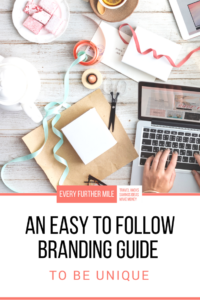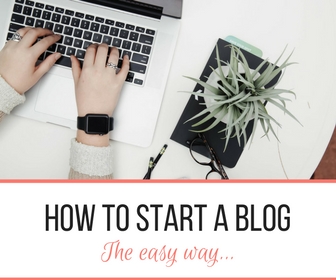Simple Branding: Easy to Follow Branding Guide

 We are a restless family of four, looking for adventure, ways to increase our funds, and more educaitonal options for our littles. We have exchanged things for experiences. Join us!
We are a restless family of four, looking for adventure, ways to increase our funds, and more educaitonal options for our littles. We have exchanged things for experiences. Join us!
You’ve decided to start your own blog/online business and you’ve heard that branding is the ‘thing to do’.
Well, you heard correctly, branding is quite important, but it doesn’t need to be intimidating. If you have not read my “6 Stages of Successful Blogging” post or my “How to Pick the Right Blog Topic & Feel Confident About it”, then I suggest you pause and do that. It’s important not to jump ahead in your blogging steps and branding will be best to work out once you have a good understanding of the blogging world and where you will fit into it. You just can’t brand something that isn’t a thing yet. Don’t worry, I’ll wait here for you to return.

…
Now that you have a brief idea of where you are going and, hopefully, a confident idea of how you want to get there, let’s talk about branding your business.
Branding is basically controlling your business image through design and vision/mission. Feel free to find someone who will help talk through this aspect with you. There are lots of Facebook groups with others who are in the same place as you and who need a partner to help them focus in on their brand. You can use this guide to get your ideas out and then connect with others to solidify your decision. Let’s go through the steps you should take to work out your the brand that you want for your business. Remember that this is how you want to get started, but you won’t be married to the idea and if in the future you realise you would have liked to go about it in a different way, you will be able to make changes. But for now, let’s see what inspires you today:
Phase #1: Name and Title
There are many intimidating parts of business. Why? Because it’s full of making decisions and those decisions always fall on your shoulders. From naming your business to how you want to make money with your business, you will always feel pressure to make the best decision, as if your business depends on it. While in the long run this is true, remember what I said, that you can make adjustments later on and these decisions are best for now and where you currently are in your process. I say this a lot, but just make the decision and stick with it, see it through and then if later on you need to make chances, then make changes. At least this way you’re moving forward and not letting your fear stop you.
So, name your business. What should you name your business? Here are a few ideas of what others do to decide:
- Name it after yourself: This is great if you are offering a service and best for those offering a coaching service (life coaching, educational coaching, fitness coaching, etc) or you’re an author who wants to have your name known to your readers. Is your first and last name available? First and middle name? Don’t make it too long; keep it to two names total and hopefully you have an easy to remember name that others can spell.
- Be direct: If your business is about hot yoga, then maybe you call it: HotYogaClasses.com (that might be taken, but you get the idea)
- Be obscure: Can’t find something that actually makes sense because there are those ‘fun’ people that like to grab up domain names to sell at a hirer price? Be obscure and try making up a word, combining words, etc. For example: Google wasn’t exactly a word that was used in most people’s vocabulary (‘Googol’ is a mathematical word that means 1 with 100 zeros following it.), but it is unique and easy to remember. Now it’s the biggest name on the web. Instead of Hot Yoga, try Hoga.com (sounds funny to me too, but people will get the idea).
- Business type: Use your business model in your name. For example, WomansFoodNetwork.com, BloggingMembers.com, PuppyCoach.com, etc
- Domain Name Generator: Can’t find something that you like? Try a domain name generator. Perhaps it will generate something perfect or just give you more ideas of what to pick.
If you went through the ‘How to Pick the Right Blog Topic’ exercise, then you should have lots of material to help you get started on business names. If not, or if you need more help, then take a piece of paper and a pen and write down a bunch of words that describe your business. What is it about? Who is your audience (Who will read your blog)? Who are you? What do you want from this business? What do others want/need from you? Try to keep it to 1-3 words that you write down and then use these words as inspiration. Tips: Here are some extra tips on choosing your domain/business name:
- Use .com if possible (because it’s most known and better with search engines), but others might work well too if you are good with the rest of your brand
- Make it short. 2-3 words would be best
- Avoid numbers and symbols
- Make it memorable and spellable
- Be sure you aren’t using trademarked names (for example: ‘worldpreneur’ is a trademarked name)
- Wait to buy your domain when you register your hosting. We suggest Bluehost because they’ve always been good to us. You can learn more here.
Phase #2 Vision/Mission:
Your vision/mission answers the what, who, why and how of your business. Write a few statements out that answer the following questions:
- Who are you?
- What inspired you to start this business?
- How do you hope to help others through your blog?
- What are people going to learn when they read your blog?
- What is your big dream?
- How are you helping others achieve their dream?
Use these answers to form a vision and mission statement for your business. Keep it to 3-5 lines (one short paragraph).
Phase #3: Tagline
Under your business name you should have a tagline that reflects what your business is about or what your vision/mission is. If you don’t want it directly under your business name, it’s still good to have as a quick philosophy statement for your blog that you can use elsewhere. Here are some examples:
- Every Further Mile: Freedom to Explore
- We are about travel, exploring education as a family and the freedom to do both
- Marie Forleo: The World Needs That Special Gift Only You Have
- She branded her own name as a life and business coach who helps (mainly) women use their gifts to create a business that is helpful to others
- Tony Robbins: Transform Your Life
- Tony is a life coach and public speaker. He loves to help transform the lives of others to meet their potential
Maybe in your journey to find the right name you came up with some great alternatives that you could use in your tagline or you can use your vision/mission statement to put together your short tagline. Keep your tagline to 3-6 words if possible.
Phase #4: Goals
Now that you have your name, your vision/mission statement and your tagline it’s time to get started on your overall goals for your website. The reason this is important is because you need to know what you want to focus on. This will help you keep some structure to your website content. It wouldn’t make sense to write a post about financing your house if your blog is HotYogaClasses.com. This is a bit of a stretch, but you get the idea. Do this exercise: On a piece of paper (or on the computer,) begin to envision your dream.
- What is your dream for the website and for your life?
- How does this translate to those who are reading your blog?
- Do they want the same as you?
- What are they getting out of it?
- What dream are you selling them?
Brainstorm the different areas you would want to focus on in your blog. For example: Hot Yoga Videos and Blog:
- Hot Yoga styles
- Becoming Active
- Releasing your negativity through the heat and embracing positivity
- Healthy eating choices/recipes
- Sessions for beginners, intermediate and advanced
- Etc
Use this material to set goals for your business. Use these guidelines to help you stay on track and deliver consistent content. Branding is about having a consistent image and message.
It’s also about having consistent visual design:
Phase #5: Colours
When picking your website colours it is best to stick with black/grey and white and one bold colour, maybe two. Hopefully you’ve figured out the bold colour we’ve used for our brand. It’s a coral pink. I picked it, not my husband because I like the freshness of the colour. It also seems to me that colours on the red side of the colour wheel stand out more than the blue side. This is not to say that blue doesn’t stand out or that lots of people don’t like it, but to say that our eye tends to be drawn to reds more.
Phase #6: Design feel
Is your design going to be simple? Artful? Bold? Try to make it reflect your personality as well as your audience. While it’s important to be true to you, it’s also important to make sure your audience is comfortable on your website. We went with simple and somewhat feminine because our audience is largely female and we wanted the attention on the important images on the website, not on the style of letters and big bold colours where there is not important information.
Phase #7 Logo
It’s time to combine our colours, design and name into a great logo. Your logo should be simple and reflect your business brand. Canva is a great free place to create your logo, but if this intimidates you then you can go onto fiverr easily enough to hire someone at a low cost to create your logo for you. Just make sure its unique and easily recognizable. Use the visual design to draw quick recognition of your brand (like the coca cola logo and colours or the McDonald’s Golden Arches) and then use your written design to show consistent quality that backs up your brand image.
Make sure to use the colour scheme and logo on everything that you can so that people get very used to seeing it. This means you can use it on your blog post images, Pinterest images, emails, eBooks, courses, or any other content you create.
Voila! You have a brand for your business! Hopefully by the end of this post you have taken the time to really flush out your brand and you are now ready for the next step. If you haven’t already come across it, we’ve put together a great free email course that brings you From Start to Launch

